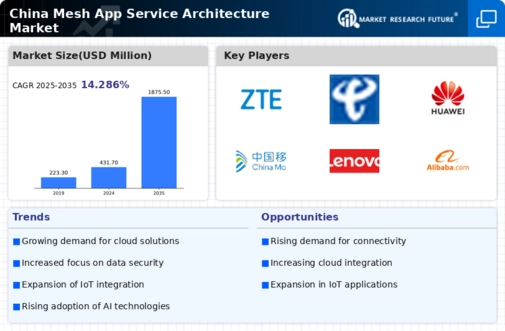Integration of IoT Devices
The proliferation of Internet of Things (IoT) devices in China is driving the evolution of the mesh app-service-architecture market. As more devices become interconnected, the demand for architectures that can efficiently manage and process data from these devices is increasing. The mesh architecture's inherent flexibility and ability to handle diverse data streams make it an attractive option for businesses looking to harness IoT capabilities. Current estimates suggest that the number of IoT devices in China could reach 1 billion by 2026, creating a substantial market for solutions that can support this growth. Consequently, the mesh app-service-architecture market is poised for expansion as organizations seek to capitalize on the opportunities presented by IoT integration.
Rising Demand for Scalability
The mesh app-service-architecture market in China is experiencing a notable surge in demand for scalable solutions. As businesses expand, the need for architectures that can seamlessly scale to accommodate increased workloads becomes paramount. This trend is particularly evident in sectors such as e-commerce and telecommunications, where user traffic can fluctuate dramatically. According to recent data, the scalability requirements in the Chinese market are projected to grow by approximately 30% over the next five years. This demand drives companies to adopt mesh architectures that facilitate rapid scaling without compromising performance. Consequently, the mesh app-service-architecture market is likely to witness significant growth as organizations seek to enhance their operational efficiency and responsiveness to market changes.
Government Initiatives and Support
The Chinese government is actively promoting digital transformation across various sectors, which significantly impacts the mesh app-service-architecture market. Initiatives aimed at fostering innovation and technological advancement are encouraging businesses to adopt modern architectures. For instance, the government has allocated substantial funding to support research and development in cloud computing and related technologies. This support is likely to catalyze the growth of the mesh app-service-architecture market, as organizations leverage government resources to implement cutting-edge solutions. Furthermore, the push for smart city initiatives and digital infrastructure development is expected to create new opportunities for mesh architectures, potentially increasing market size by 25% in the coming years.
Focus on Enhanced Security Protocols
Security remains a critical concern for organizations in China, particularly as cyber threats evolve. The mesh app-service-architecture market is responding to this challenge by integrating advanced security protocols into its frameworks. Companies are increasingly prioritizing architectures that offer robust security features, such as end-to-end encryption and micro-segmentation. Recent statistics indicate that nearly 45% of enterprises in China have reported security breaches in the past year, underscoring the urgent need for secure architectures. As a result, the mesh app-service-architecture market is likely to expand as businesses invest in solutions that not only enhance security but also ensure compliance with stringent regulations. This focus on security is expected to shape the future landscape of the market.
Shift Towards Agile Development Practices
The shift towards agile development methodologies is reshaping the landscape of the mesh app-service-architecture market in China. Organizations are increasingly adopting agile practices to enhance collaboration, speed up development cycles, and improve product quality. This trend is particularly relevant in the technology sector, where rapid innovation is essential for maintaining competitive advantage. As agile practices become more prevalent, the demand for architectures that support continuous integration and delivery is likely to rise. Recent surveys indicate that approximately 60% of software development teams in China are now utilizing agile methodologies, which could lead to a corresponding increase in the adoption of mesh app-service-architecture solutions. This shift is expected to drive market growth as companies seek to align their development processes with modern operational demands.




















Leave a Comment